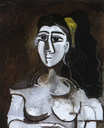©Pablo Picasso - Still Life with Glass Under the Lamp 1962
 |
 |
 |
 |
 |
 |
 |

Still Life with Glass Under the Lamp 1962
53x64cm Linoleum cut
The Museum of Modern Art, New York
The image is only being used for informational and educational purposes
<< Previous G a l l e r y Next >>
From The Museum of Modern Art, New York:
Renowned for painting as well as sculpture, Pablo Picasso is arguably the greatest printmaker of the twentieth century. He created more than two thousand printed images, working primarily in intaglio techniques but also, for extended periods, in lithography and linoleum cut. It was usually the influence of a master craftsman in a collaborative workshop that served as the impetus for Picasso's printmaking, as new techniques fueled his imagination.
Picasso's early prints reflect his evolving artistic language and his place within the major modern movements. The Frugal Repast, of 1904, in a richly inked proof from the shop of printer Auguste Delâtre, evokes a sense of mystery and nobility surrounding poverty, recalling the Symbolist aesthetic of Picasso's Blue and Rose periods. Two years later, a woodcut of his companion, Fernande Olivier, betrays the simplified forms he found in Iberian sculpture and a raw expressionism inspired by tribal art.
Picasso's illustrations for Saint Matorel, with text by his friend Max Jacob, incorporate the Cubist idiom with which he is most closely associated. While this abstracted language of forms served him throughout his career, his work remained aligned with figurative imagery. In his great prints of the 1930s, created in collaboration with master printer Roger Lacourière, his allegorical inclinations are revealed, while these works also share Surrealist preoccupations with the unconscious.